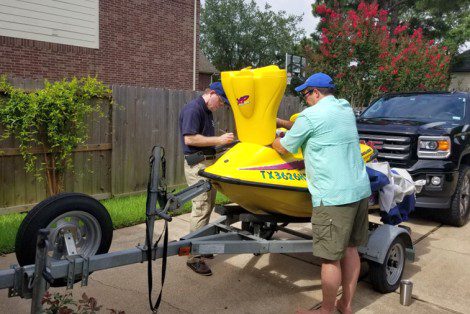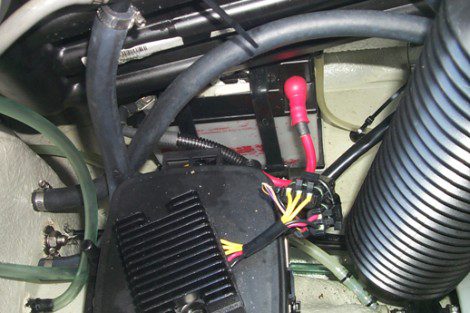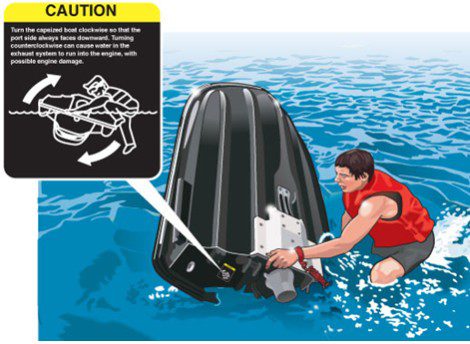 By Bob Currie, Recreational Boating Safety Specialist
By Bob Currie, Recreational Boating Safety Specialist
U. S. Coast Guard Auxiliary Station Galveston Flotilla
A personal watercraft (PWC) is defined as a type of motorboat that is less than 16 feet in length which is specifically designed to be operated by a person or persons sitting, standing, or kneeling ON the vessel rather than INSIDE the vessel. The term PWC includes jet skis, wet bikes, wave runners, etc. Any person being towed by a PWC is considered to be an occupant of the PWC and is required to wear a life jacket. This includes towing tubes and floats.

Coast Guard Auxiliarist Don Ross (left) performs a Vessel Safety Check on a PWC
The Station Galveston Flotilla of the US Coast Guard Auxiliary operates out of the USCG Station Galveston base on Galveston Island. They aid the Coast Guard by providing maritime observation patrols in Galveston Bay; by providing recreational boating vessel safety checks; and by working alongside Coast Guard members in maritime accident investigation, small boat training, providing a safety zone, Aids to Navigation verification, in the galley, on the Coast Guard Drone Team and watch standing.
Since the USCG considers the PWC a class A inboard boat it is required to be registered, just like a boat; the registration certificate must be onboard while the craft is in use. The USCG states the registration number and hull identification numbers are to be visible. The registration numbers for Texas residents are required to be in plain block letters and numbers, a minimum of three inches in height, and the registration sticker must be placed three inches aft of the registration numbers on each side.

Boater Education Requirement
Boater Education training is recommended for all boat operators and required for those persons born on or after September 1, 1993. If you are one of those who is required to have the training, you must have the certificate with you on board the vessel.
Required Safety Equipment for PWC
First, all equipment for regular motorboats also apply to PWC. This means you must have a Coast Guard-approved fire extinguisher and a sound producing device such as a whistle. I recommend you have the whistle attached to your life jacket by the whistle cord so that when you end up in the water you can readily warn nearby vessels of your position. In a departure from the regular boat regulation, PWC occupants must WEAR a USCG approved wearable life jacket. Inflatable life jackets are prohibited on PWCs. Since PWCs are prohibited from operating at night, only a daytime Visual Distress Signal is required. An orange flag will serve the purpose.
It is recommended that you wear a life jacket that is speed rated. Speed rated life jackets usually have a zipper, three or more straps, or a zipper plus three or more straps. The fine print on the inside of the life jacket will say it is rated for high speed and may or may not give you an actual speed for which it is rated. When you hit the water at 60 mph, you want a life jacket that is going to hold up.
If the PWC is equipped with a cut-off or kill switch, it must be attached to the operator or operator’s clothing. I just ordered for use on my boat a special wrist band with a quick disconnect. Some PWC are equipped with a slow circle mode that puts the PWC into a circle at idle speed. They may or may not also have a kill switch. If they have a kill switch, you must use it.

As with any inboard boat, the bilge must be free of debris and clean. Battery posts must be covered. There must be a backfire flame arrestor, but forced ventilation is not required.
PWC Operator Age Limit
There is a regulation that limits how young a PWC operator can be, sort of. Here is the rule: Children under 13 are specifically prohibited from operating a PWC unless accompanied on board by a person at least 18 years of age who can lawfully operate a PWC. So, yes you can have Little Johnny or Little Janie operate your PWC as long as you are sitting behind her. Note that the required boater education certification applies to you but not Little Johnnie or Little Janie, because technically you are the boat operator.
Operating a PWC at Night
Did you ever wonder why there are no navigation lights on a PWC? Well, it’s because it is unlawful for any person to operate PWC at night (sunset to sunrise). Everyone who watches Lone Star Law knows that. Those game wardens are always nailing those sunset jet skiers. You should plan your trip so that you are off the water well in advance of sunset.
Wake Jumping Your PWC
Everyone knows that it is against the law for a PWC to pass behind a boat for the purpose of jumping their wake, right? Well no, that’s not the rule. The rule is “it is unlawful to operate a PWC and jump the wake of another vessel recklessly or unnecessarily close.” You will find that this rule is enforced. You can do it safely, but you must not endanger yourself, another person in the water, or another vessel. Don’t get too close to the boat whose wake you are jumping, and make sure there are no other vessels nearby. Make sure your trajectory doesn’t put you on a collision course with anything.
More PWC Regulations
I group these regulations into the “I didn’t know that” category. That’s what people say when they are stopped for violating one of them. This is why I recommend a Boater Education Course to everyone, no matter when they were born. You learn all sorts of stuff in those courses. Here are the ones the State of Texas wants you to know about in particular:
- It is unlawful for any person to operate at a speed greater than is reasonable and prudent or greater than will permit him to bring such boat to a stop within the assured clear distance ahead. Remember, boats don’t have brakes. PWC lose steering when you shut off on the throttle, since there is no form of rudder.
- It is unlawful for any person to operate so as to cause a hazardous wake or wash. This doesn’t say you can’t create a big wake or wash, but you can’t do it if it could possibly endanger another person or craft nearby. When deciding whether to do that porpoise move or a series of tight circles, consider approaching boats. A boat might be a quarter mile away, but it might also be moving at great speed, and a doughnut within its projected path could cause the operator to make an unsafe turn to avoid collision. You don’t even have to be close to cause a boating accident.
- It is unlawful to operate in a circular course around any other boat or PWC occupied by a person engaged in fishing, waterskiing, or similar activity. Notice that this regulation does not prohibit circling. It just prohibits circling where such interferes with the other vessel’s activity. It is particularly dangerous whenever a skier from another boat is in the water. Of course, you are allowed to circle your own skier in the water for recovery purposes. Also, circling another PWC operator so that you can have a conversation is okay. Circling is how you stay upright. Coming to a complete stop can cause you fall off your PWC. Just keep in mind the mentioned times when it is not allowed. Keep in mind that a fisherman may have a line out a hundred yards or more. You really don’t want to suck that monofilament up into your impeller.
- It is unlawful to moor or attach to any buoy, beacon, light marker, stake, flag or other aid to safe operation, or to move, remove, displace, tamper with, damage or destroy the same. The best way to do it is to have your own mooring buoy. I see them all the time on my beach. This keeps the PWC from banging around on the beach. Tie up to your personal buoy, but not to anything else and you should be okay. This rule applies to all vessels. I see people tying up to a particular day beacon off Rollover Pass quite often.
- It is unlawful to anchor in the traveled portion of any river or channel so as to prevent, impede, or interfere with safe passage of any other boat through the same area. This rule more often applies to PWC fishermen who may anchor in a channel such as the channel between Yate’s Bayou and Big Pasture. The same rule applies to other vessels. Anchor toward the side of the channel and you will be okay.
- It is unlawful to operate within an area designated as bathing, fishing, swimming, or otherwise restricted. While we don’t have designated swimming areas on Bolivar Peninsula, keep this rule in mind when operating towards shore. It is your responsibility to not run over swimmers. Steer toward an area away from swimmers and walk your PWC down the beach if necessary.
- It is unlawful to operate within designated “no wake” areas except at headway speed without creating a wake. I know, it is hard to steer a PWC at idle, but this is one of the most often ticketed rules.
- It is unlawful to operate within 50 feet of a “Diver Down Flag” or operate a boat within 150 feet of a “Diver Down Flag” except at headway/steerage speed. As a former scuba diver, we always listen for a propeller when coming to the surface. We ask that you look out for us, too. If you see a boat that is anchored, be sure to observe for the Diver Down flag.
The above is not a complete list. It simply reflects the most common and/or dangerous violations. BoatUS offers a free online course at
Righting Your PWC
PWCs are designed to float when capsized. There is, however, a prescribed method for righting a capsized PWC. Most manufacturers have placed a decal at the rear or bottom of the craft that indicates the direction to roll your PWC to return it to an upright position. If no decal exists, check your owner’s manual or ask the dealer. With this information, you should be able to roll the PWC over and reboard with little trouble. If you roll it over the wrong way, you could damage your PWC.

Collision Avoidance
The Rules of the Road are all about avoiding a collision between two vessels. One method of avoiding a collision is to stop. That is often not enough when a PWC is involved because a PWC will coast quite a distance when the throttle is shut off. With a conventional propeller-driven vessel the best course is to reduce speed and turn to avoid collision. That combination could prove deadly for a PWC operator because shutting off or reducing throttle also prevents the PWC from turning. A PWC can only turn under power applied from the throttle. No matter how much you turn the PWC handlebars, if you are not applying power you will continue to move straight as an arrow. There is no rudder on a PWC. The direction the jet points is where the boat will go, provided that the jet is producing thrust. You must learn and follow this concept.
Summary
There are regulations that apply to all boats, and there are regulations that apply specifically to PWC. I have covered the important ones above, especially where the rule is different. The biggest differences are the no operation at night rule and the rule that requires you to wear a life jacket at all times. Enjoy safe operation, and I hope to see you on the water. Don’t forget your plugs!
For more information on boating safety, please visit the Official Website of the U.S. Coast Guard’s Boating Safety Division at www.uscgboating.org. Questions about the US Coast Guard Auxiliary or our free Vessel Safety Check program may be directed to me at [email protected]. SAFE BOATING!
[July-27-2021]

 Posted in
Posted in 
























